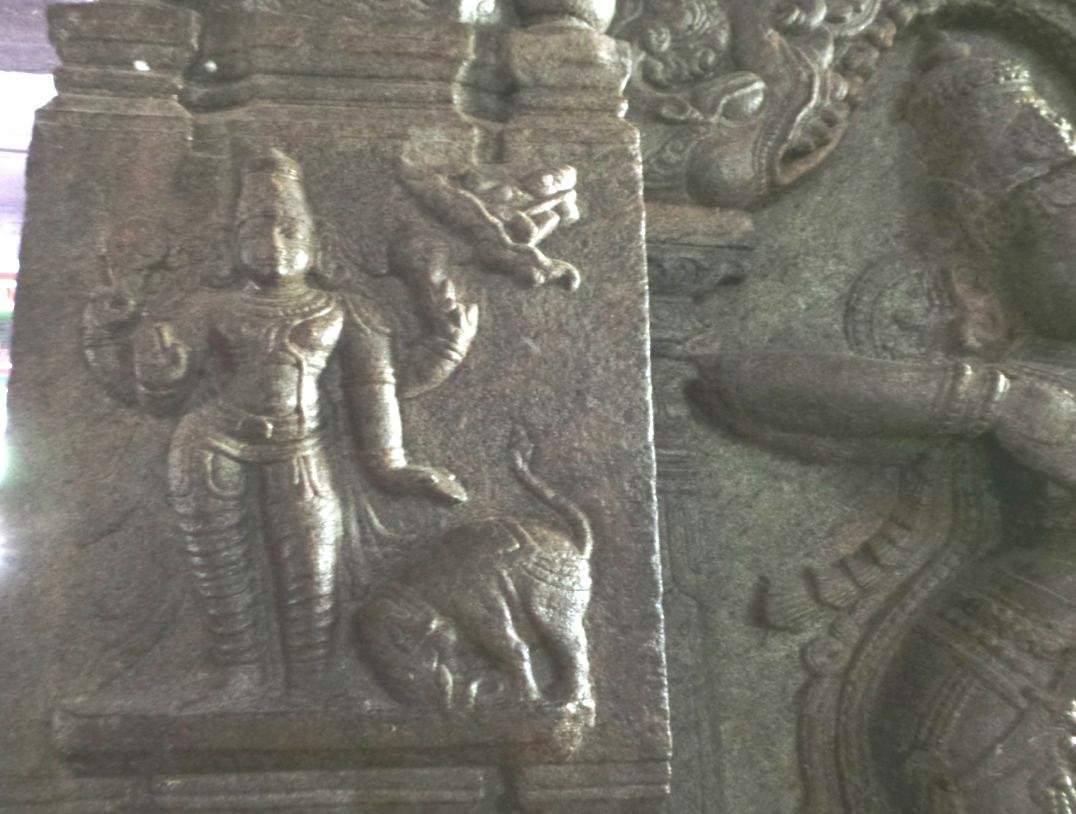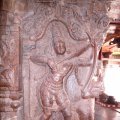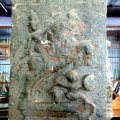Sculptures in temples in Kumbakonam: photo 141
Photo 141 of 640 in Gallery: Sculptures in temples in Kumbakonam

Image title: Figure 140. Gajendra Moksa
Description of the photo
On the same pillar on the left side of Manmatha is a sculpture of Gajendra Moksa. We can see Lord Visnu standing in Ayata Sthana. He is four handed. His main right hand is in Abhaya Hasta. His left hand is blessing Gajendra. His back left hand is holding Sankha and his back right hand is holding Cakra. On his left side below his left hand we can see the elephant Gajendra bowing down in surrender.
Gajendra, in his previous life was a great devotee of Visnu called Indradyumna who was also a great king. One day, Agastya, a great sage came to visit the king but Indradyumna sat heavy on his seat, did not rise up to receive the Rsi with the respect. A fuming Sage Agastya noticed that the great King, despite the greatness of his good deeds, still has traces of Ahamkara in him and elucidated to the King that in his next birth, he would be born as an elephant in which he would be taught the hard way that self is to be renounced and surrendered to the Lord. Gajendra Moksa or The Liberation of Gajendra is a Puranic legend from the 8th Skanda of Bhagavad Purana, one of the most sacred books in Hinduism. It is one of the famous exploits of Lord Visnu. In this moving episode Lord Visnu came down to earth to protect Gajendra, the Elephant from the clutches of Makara, the Crocodile and awards him Moksa or salvation. Gajendra is then said to have attained the similar four-armed form–Caturbhuja of God and goes to Vaikuntha with Lord Visnu.
This side of the pillar has two sculptures. The main sculpture is that of a horse rider sitting on a horse holding a sword with his right hand. Below him is a soldier with a sword and a shield.
Above towards the top is a sculpture of Lord Visnu with Caturbhujam [Caturbhuja], front right hand in Suci Hasta, front left hand holding Gada. The back right and left hand are holding Cakra and Sankha respectively. He is standing in Ayata Sthana.
Gallery information:
Kumbakonam is considered as one of the holiest places in Tamil Nadu and is known for its temples and Mathas (monasteries which were centres of Brahmanical learning). These photographs depict the connection between the sculptures in the temples and Natya Shastra and related texts dealing with iconography.
Photo details:
High resolution:
Download file
Size: 103.25 KB
Resolution: 1076 x 814
© Copyright: see gallery source

